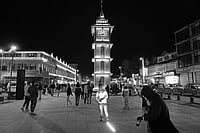Many days have passed since the day I looked out of the car window during one of my shotgun drives across the various bountiful terrains of Kashmir, involuntarily noticing silhouettes of young boys and girls swooshing across my peripheral vision, which, if left to its volition, was hoping to stay fixated on the sights of the golden rays of the sunset perforating the mighty pine tree thickets of the valley we find ourselves nestled in.
In one such passing-by of sorts, as my eyes registered only in passing the shapes of the clothed bodies of this generation, the generation immediately after mine, the Gen-Z as they are called, I had a realisation that had been marinating itself subconsciously in my head for days until that day; this day of revelation.
My head, bobbing and sometimes vibrating against the glass on the window, which was slightly dusty from that one temporarily off-road detour we had taken a few minutes earlier, blurted out through its (sometimes my) mouth something that would stay with us for weeks and perhaps years to come.
‘Surat-e-haal kaafi Balenciaga hain’—The state of affairs is quite Balenciaga—I had said, with the sigh of someone drifting dizzyingly into the irrelevance of the slightly older generation.
As I said this, my friend maintained, not very well albeit, a composure of profundity, while also clearly at the crinkled-face brink of laughing out loud. He was not maintaining appearances; he was, in fact, truly struggling. He was, after all, my friend of three years, privy to every secret of mine and not without the gall and friendly capital to mock my less-than-quotable quotes. There was, in this sentence, such stupid genius that even he did not know what best to do.
I, on the other hand, knew I had spilled gold. If only I had a stake in a tee shirt manufacturing industry, I would have sold millions with this quote, I thought to myself, and rightly so, I thought again. So, I did what any daydreamer in their right daydreaming mind would do. I went to the free and generous services of Canva, and then that site Vista Print that makes tee shirt designs, and made a design too minimalistic (read bland) to do justice to the peppy brilliance this was capable of. So, I decided against it, and hence trashed it. For now. For then, I mean. However, it was not just the aesthetic and auditory brilliance of this quote, but the prophetic truth in it that
1. brought my friend to the brink of an exaggeratedly confused emotion,
2. made Tufail Nazir—one of the top hip-hop artists Kashmir has ever produced—say that ‘this should be a slogan’, and
3. got every friend of mine started quoting it, expressing it, as often and as easy as popping a box of Tic Tacs.
To my credit, I often say quotable things—as my friends from college would tell you—the ones who spent the most time vegetating with me over a couch that was itself no stranger to vegetation.
And this was, in this moment, bobbing and vibrating in the car, the near-thirty-year-old me with an even more quotable wisdom, leaving crumbs for the world to Hansel and Gretel around. Or so I thought.
So, what was this quote the revered tail end of? Over time, as I pointed out, through the streets of Kashmir, and as my friends would also start noticing, only now along with me: Surat-e-haal in Kashmir, truly were Balenciaga all over. No matter where you looked, you could see in the newer generation in Kashmir, a place which in 2009 was taken over by Iran’s hijab and jeans aesthetic, a newfound Balenciaga revolution.
What on earth then is this Balenciaga attire?

Characterised by loose hanging, bold-but-bland coloured, sometimes floral and not necessarily and mandatorily floral clothing, sufficed in the lower half most often by a pair of washed out (brownie points to torn) jeans, or baggy pants of corduroy with an in-built air-conditioning system, most often ending at the lower extremity with white sneakers, with the attire itself spreading out in all perceivable directions from the body, this look is often seen to be swaying in the wind with an expression that imitates the cold expression on the wearer’s face—the wearer himself albeit, perceivably and assumedly, almost certainly, with a soft interior.
There was, of course, the pouting, brooding romantic of the 2015s, and now we had the Poker-Face Romantic stopping at nothing but the sight of a red and thorny rosebush growing carelessly by the side of the pavement, away from the colonially overarching lawns—the aesthetic, domestic and ubiquitous remnants and symptoms of colonialism which this Balenciaga life was vehemently against. This attire, hence, exudes a sense of carelessness for how the wearer looks—a depiction and symbolism of confidence and thrift pride, even though the world of thrift itself may never feature in the Balenciaga specimen’s wardrobe. Make no mistake about it, however. This is, by all means, a fashion statement.
In an odd turn of events however, which nobody envisaged, the Balenciaga outfit, as it happens, finds a brilliant and surprising counterpart/comrade in cultural, even religious acceptability. You see, these Balenciaga-esque outfits, when appended with a Hijab —are essentially … Islamic.
The Balenciaga outfit finds a counterpart in cultural And religious acceptability. these Balenciaga-esque outfits, when appended with A Hijab, are essentially Islamic.
The Islamic attire for women, as well, according to how Islam demands its women be, is characterised by loose fitting attire (the abaya, the burqa—the less ‘revealing’, loosely hanging clothing) so as to conceal the curves of a female body—so as to camouflage the secondary sexual characteristics of a growing female anatomy/body, growing generously at the hips and the bosoms—the Achilles’ heel of what the Balenciaga generation itself would call ‘God’s Strongest Soldier’.
The rise of the Balenciaga in Kashmir, to be precise, is not an individual event, disconnected from the psyche of the wearer. A new silent gargantuan tide has, as of this moment, swept over the world. This tide, murmuring but tectonic and perhaps more powerful than its predecessor—the soon to be erstwhile Postmodern, is making inroads into the psyche of the young, already having laid neural pathways that seem to be here to stay.
The ‘excesses’ of postmodernism and the insistence on subjectivity, the vehement rejection of religion in the past decade has now catapulted, whiplashed, with us having supposedly pulled too hard on a string only finitely plastic, and only meant for finite plastitude, is now backfiring with people now finding respite only in going back to the traditionalism in belief, the institution of marriage, and what’s more, even taking pride in it. Who woulda thunk! This phenomenon has seen a rise in the insistence on monogamy, marriage, chastity, loyalty—which have now indeed become fashionable. Very much like the Balenciaga outfit, which at some point in the past, represented the exact opposite—the postmodern specimen—the other side of this polar spectrum.
The Balenciaga outfit, as I see it, is such. In males, it debatably holds no more significance than the comfort and the sense of fashion it provides, the sense of relevance the spiky hair of the early 2000s provided, seen in retrospect only as a deplorable abomination, but once coveted and much adored. In the young women of Kashmir, however, as my friend Nawal will tell you—it has proven to be a fashionable way to be Islamic/religious, a step away from postmodernism albeit in a postmodern attire, calling and reaching out to the times of the jeans-hijab inception of the earlier 2000s brought about by the sudden discovery and sensationalisation of Iranian cinema through bootleg compact discs.
What better attire to emulate, especially for the Shia Muslims of Kashmir, than the paragon of Shia Islam, Iran itself? And that’s what had done it then.
Surat-e-haal Kaafi Balenciaga hain, meanwhile, over the course of the last few weeks, has now morphed from a quote echoed and repeated within a dilly-dallying crowd of two, to a verse now on the mouths of a crowd of perhaps seven, escaping its original intent and purpose of defining (only) the state of aesthetic fashion in Kashmir, and instead now representing, in my circles, the Balenciaga state of mind. A Balenciaga state of mind is, hence, pride in the lack of pride, a display of the lack of display, a maximal minimalism if I may; an embrace of the idea of thrift, if not thrift itself, and largely, a fight against brands by making a brand out of the brandless discarded nameless street-side refuse.
The word Balenciaga in itself seems to be a lot more than the name of the brand itself. When said with a sigh, such as ‘*sigh* ‘Surat-e-haal Kaafi Balenciaga hain’, your friend immediately understands that what you mean has something to do with the drudgery of existentialism. Or even mischief. With a twinkle in your eye, you could say ‘Surat-e-haal Kaafi Balenciaga hain’ as if ready for trouble and embracing it, as if rubbing hands next to a crackling fire, burning logs of wood you stole from a neighbour in the forest.
The Balenciaga phenomenon, hence, is not depicted by a name-tag, or a price-tag on the back of the shirt but solely by the characteristic feature of its hanging about loosely on a loosely swaying body, male and female, and saying out loudly but silently with pursed lips—we do not care about brands, and that is Balenciaga.
(Views expressed are personal)
Tabish Rafiq Mir is a writer, photographer, and illustrator residing in Srinagar, Jammu and Kashmir, where he produces political commentary and satire. His work can be accessed at https://tabishrafiqmir.com.
























